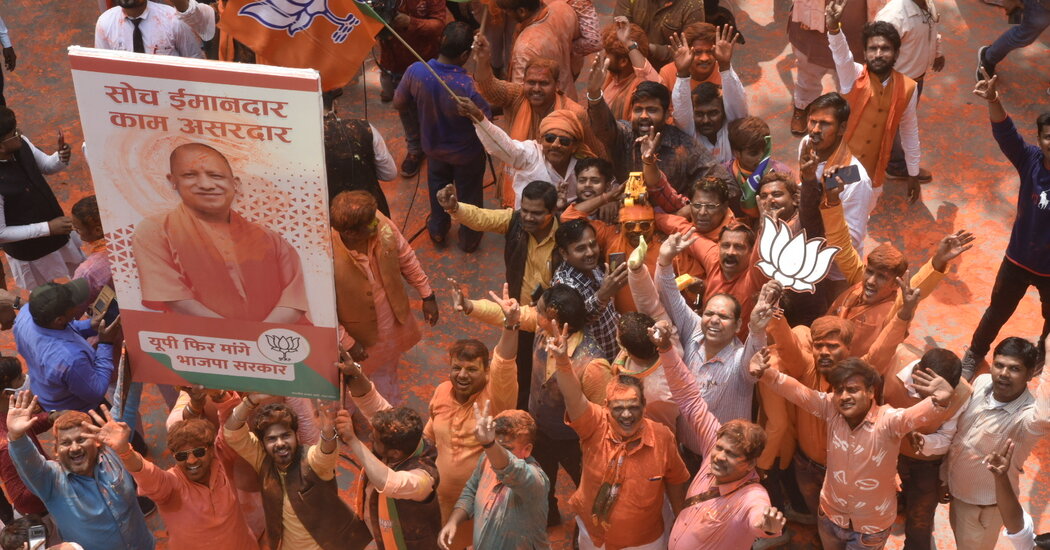
LUCKNOW, India — Prime Minister Narendra Modi’s national governing party is set to remain in power in India’s most populous state, Uttar Pradesh, according to early election results released on Thursday, continuing the party’s record of repeated success at the polls despite mounting economic hardship.
The victory by Mr. Modi’s Bharatiya Janata Party, or B.J.P., marks the first time in more than three decades that voters have returned an incumbent bloc in power in Uttar Pradesh, home to about 240 million people. It further consolidates the rise of Yogi Adityanath, a hard-line Hindu monk who has been the state’s chief minister for five years and is increasingly viewed as a potential successor to Mr. Modi.
Crowds of B.J.P. supporters began arriving outside the party’s office in Lucknow, the capital of Uttar Pradesh, before the results started to come in. The mood was jubilant, with young men breaking into cheers and chants as television anchors tallied seats on a large screen. By late afternoon, the B.J.P. was leading in 253 seats of the 403-seat assembly in Uttar Pradesh, down by about 60 seats from their performance in 2017 but still a comfortable margin to form the government.
“I am so happy that the B.J.P. is winning,” said Arpit Mishra, a 19-year old party worker wearing a crisp floral jacket and a scarf of saffron, the party’s color, wrapped around his knuckles.
“They will give a push to Hindutva,” he said, referring to the party’s vision of reshaping India along explicitly Hindu lines. “Our life as Hindus will change.”
Results were also being released Thursday from four other Indian states that have voted over the past month, and they suggested that India’s opposition politics might be going through a major transformation. Most notably, the Indian National Congress Party, which held power for most of India’s history since it gained independence from Britain in 1947, seemed to be continuing its rapid decline.
Early results showed that Congress was losing in Punjab, one of the few states where it still held power, and it was trailing the B.J.P. in close races in the smaller states of Goa and Uttarakhand. The Aam Aadmi Party, which controls Delhi, had a substantial lead in Punjab, raising the prospect that it would become the first of India’s smaller regional parties to gain control of a second state.
Many of the regional parties are trying to look beyond Congress to Mr. Modi, hoping to put up a fight in the 2024 general elections. A victory in Punjab would give Aam Aadmi — whose name means “common man” — an edge over other opposition blocs, analysts said.
Still, while Mr. Modi’s party has sometimes struggled against strong regional parties in state and general elections, consolidating any of them into a proper opposition to challenge Mr. Modi’s grip on India would not be easy or quick. And Congress, the largest opposition party with a national presence, has appeared increasingly vulnerable.
Celebrating with a crowd of supporters, Arvind Kejriwal, the Aam Adami Party chief, listed all the big names in Punjab that he said were brought down by candidates of his party. Charanjit Singh Channi, Punjab’s chief minister for the final months of Congress government, was defeated by an Aam Aadmi candidate who works at a mobile phone repair shop, Mr. Kejriwal said.
“This revolution started in Delhi, now in Punjab, and this revolution will spread around the country,” Mr. Kejriwal said.
With exit polls earlier indicating that the races in both Goa and Uttarakhand could be tight, leaders of Congress flew into both states in recent days to try to head off any last-minute “poaching” by the B.J.P. — that is, attempts to persuade winning candidates to switch sides. In 2017, the B.J.P. used such tactics to form the government in Goa, even though Congress had won a plurality of the seats.
This time, prominent members of Congress gathered at a Goa hotel for what party leaders said was a birthday celebration for one of them, and its candidates were offered rooms overnight. Indian media reports said it was an effort by the party to stick together and block last-minute maneuvers by the B.J.P.
“Nobody can poach us even if they try their best,” said Girish Chodankar, the Congress president in Goa. “We have taken all kinds of precautions.”
But by late afternoon Thursday, it was clear that the B.J.P. was winning in Uttarakhand, and had enough seats in Goa to form the government with the help of a couple of independent candidates. The B.J.P. was also leading in the small northeastern state of Manipur.
Much of the attention during the election season has been focused on the prize state of Uttar Pradesh, not just because of its size but because of how consequential it could be to the future of Indian politics.
Mr. Adityanath faced a tough fight from the opposition Samajwadi Party, taking heavy criticism for his handling of Covid-19 in Uttar Pradesh and a worsening economic plunge. During the deadly second wave of the pandemic, the state’s health system buckled, with reports of oxygen shortages. Images of dead bodies on the banks of the river Ganges, which is sacred to Hindus, were frequent.
Still, analysts projected that Mr. Adityanath would comfortably remain as chief minister, even if he won with a slightly smaller lead than in 2017 — again confirming the B.J.P.’s ability to mobilize and consolidate a strong support base despite short-term hardships.
Mr. Adityanath, who always wears his saffron monk’s robe in public, has furthered Mr. Modi’s vision of India as a “Hindu first” nation with his own brand of strongman politics.
Mr. Adityanath has publicly railed against what his supporters call “love jihad”: interfaith marriages, which many Hindu nationalists claim are merely attempts by Muslim men to convert Hindu women. He has also banned the slaughter of cows, seen as holy by many Hindus.
Mr. Adityanath has had cow shelters built to house aging cattle, which were soon filled well beyond capacity, so much so that in parts of Uttar Pradesh, the destruction of crops by stray cattle became an election issue.
He has also encouraged Hindu vigilante groups — some of which he helped to start, before becoming chief minister — to see that the ban on cattle slaughter is enforced, and to be on the lookout for cases of “love jihad” That has often led to violence against Muslims.
Mr. Adityanath’s methods “may serve as a model for other states” in India, said Gilles Verniers, a professor of political science at Ashoka University who studies Uttar Pradesh’s politics.
“We’ve seen some leaders cite Adityanath as a model — not just for his policies, a mix of religion and welfare, but for the strongman politics he represents,” Professor Verniers said.
Karan Deep Singh reported from Lucknow, Uttar Pradesh, and Mujib Mashal from New Delhi. Hari Kumar contributed reporting from New Delhi.




